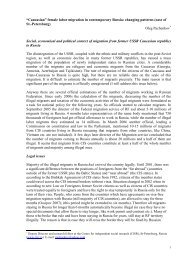THORIUM AS AN ENERGY SOURCE - Opportunities for Norway ...
THORIUM AS AN ENERGY SOURCE - Opportunities for Norway ...
THORIUM AS AN ENERGY SOURCE - Opportunities for Norway ...
You also want an ePaper? Increase the reach of your titles
YUMPU automatically turns print PDFs into web optimized ePapers that Google loves.
4.1.1 Mining and Extraction<br />
The Front End of the Thorium Fuel Cycle<br />
Thorium is found in a number of minerals. There<strong>for</strong>e, there are several basic process flow sheets<br />
with modifications that can be considered <strong>for</strong> metal recovery [24]. The thorium is often associated<br />
with other minerals and may be present as a by-product of another process. Examples of this are<br />
the beach sands concentrates in which titanium and zirconium may be the metals of primary<br />
interest, or the processing of uranium ores, such as those found in the Elliot Lake area of Canada,<br />
where associated thorium can be recovered as a by-product. Hence there are several process<br />
alternatives.<br />
Physical and Magnetic Separation: Individual minerals - ilmenite, rutile, monazite, zirconium,<br />
sillimanite and garnet - are separated by utilizing the differences in their physical properties, i.e.<br />
specific gravity, magnetic susceptibility, electric conductivity and surface properties. The wet<br />
concentrate is passed through rotary dryers at up to 150ºC, the dried feed then being<br />
electrostatically or electromechanically treated. The electrically conducting ilmenite and rutile<br />
constituents are separated first. The non-conducting monazite, being heavy and moderately<br />
magnetic, is isolated by high intensity magnetic separators. The resultant concentrate contains<br />
98 % monazite. Usually, feeds containing 1 - 2 % of heavy minerals found in combination with<br />
monazite can be concentrated to 90 % heavy minerals with an overall recovery of 85 - 90 %.<br />
Heavy Metal Chemical Extraction: The chemical properties of thorium and rare earth elements<br />
associated with it are similar, so their separation is difficult and time consuming. Concentrates of<br />
the rare earths must be chemically processed to separate them from the other components<br />
<strong>for</strong>ming the mineral and from impurities. Monazite, the chief commercial ore from which thorium<br />
is extracted, is chemically inert and any chemical treatment <strong>for</strong> extracting thorium must initially<br />
be very severe to achieve the complete dissolution necessary <strong>for</strong> the separation of the rare earth<br />
elements, uranium and phosphates. The most common dissolution processes are: (1) acidic – using<br />
highly concentrated sulphuric acid [25], and (2) alkaline – using highly concentrated sodium<br />
hydroxide [22].<br />
4.1.2 Refining<br />
For nuclear applications thorium has to meet stringent requirements of purity, particularly<br />
concerning neutron absorbing elements. This purity is obtained industrially by solvent extraction,<br />
by ion exchange, or by direct chemical precipitation.<br />
Solvent Extraction: This process makes use of the different solubilities of some heavy metal<br />
compounds in organic solvents which are immiscible with water. Successive transfer operations<br />
between the aqueous and organic phases lead to a relative concentration of one heavy metal in<br />
the aqueous phase and another in the organic phase. In purifying thorium by this process, the<br />
crude thorium produced is converted to a nitrate which exists in an aqueous phase. Contact<br />
between the aqueous carrier and the organic solvent (tributyl phosphate (TBP) in kerosene or<br />
hexane) transfers thorium to the solvent from which it is stripped by scrubbing with dilute nitric<br />
acid. Nuclear-grade thorium nitrate is obtained with more than 99 % thorium purity.<br />
Ion Exchange: This is an effective way of separating individual lanthanides in a pure state.<br />
Direct Precipitation: Either <strong>for</strong>eign ions are added to precipitate insoluble salts, or variations in<br />
solubility with pH of complex salts are exploited.<br />
If there is uranium present with thorium and rare earth elements, a more sophisticated<br />
extraction flow sheet, with two TBP concentrations and appropriate scrubbing and stripping<br />
31

















